KSEEB Solutions Class 8 Science Chapter 9 Sound Points To Remember
Sound: Vibrations that travel through the air or another medium and can be heard when they reach a person’s or animal’s ear.
Musical Sound: The sound that produces a pleasing effect on the ear. Noise: The sounds that produce a jarring or unpleasant effect.
Types of Sound:
1. Audible Sound: Vibrations whose frequency lies between 20 Hz to 20,000 Hz (20 kHz) are heard by the human ear.
2. Inaudible Sound: The sounds having frequencies above 20,000 Hz and below 20 Hz cannot be heard by the normal human ear.
Low-frequency sounds that cannot be heard are called infrasonics.
High-frequency sounds that cannot be heard are called ultrasonics. In human beings, the
vibration of the vocal cords produces sound. Sound travels through a medium (gas, liquid, or solid). It cannot travel in a vacuum.
The eardrum senses the vibrations of sound. It sends vibrations to the inner ear. From there, the signal goes to the brain. That is how we hear.
Higher the frequency of vibration, the higher the pitch, and the shriller the sound.
Unpleasant sounds are called noise.
Excessive or unwanted sounds lead to noise pollution. Noise pollution may pose health problems for human beings.
Lack of sleep, hypertension (high blood pressure), anxiety, and many more health disorders may be caused by noise pollution.
A person who is exposed to a loud sound continuously may get temporary or even permanent impairment of hearing.
Attempts should be made to minimize noise pollution. Silencing devices must be installed in aircraft engines, transport vehicles, industrial machines, and home appliances.
Plantation on the roadside and elsewhere can reduce noise pollution.
Amplitude: The maximum extent of vibration of the vibrating body from its mean position is known as its amplitude.
Time Period: One complete to-and-fro movement of the pendulum around its mean position is called one oscillation. The time taken by the vibrating particle to complete one oscillation is called the time period.
Frequency:
1. The number of vibrations made by the vibrating body in one second is known as its frequency.
2. The SI unit of frequency is the hertz (Hz).
Characteristics of Sounds:
1. Loudness: The sensation produced in the ear which enables us to distinguish between a loud and a faint sound. The larger the amplitude of the vibration, the louder the sound is produced. It is proportional to the square of the amplitude.
2. Pitch: The characteristics of sound which distinguishes between a shrill sound and a soft sound. The higher the frequency of vibration, the higher the pitch and shrillness.
3. Quality: Characteristic which enables us to distinguish between musical notes emitted by different musical instruments or voices even though they have the same pitch and Loudness.
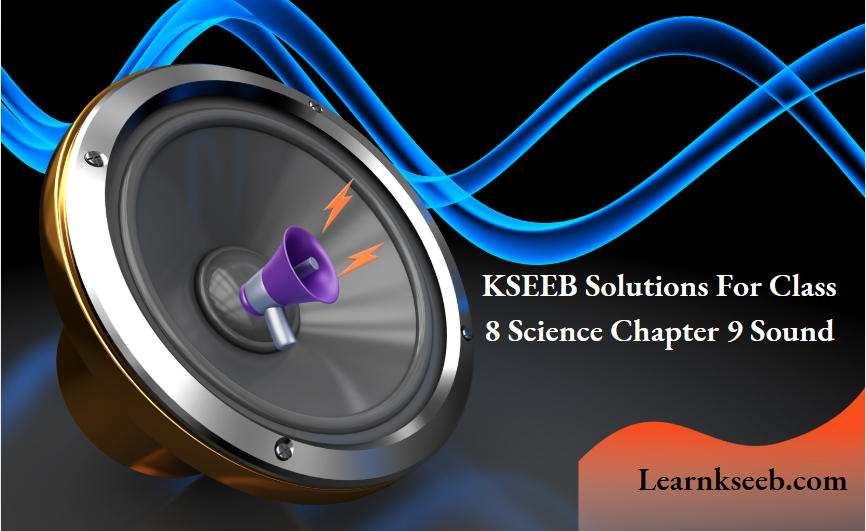
Kseeb Solutions For Class 8 Science Chapter 9 Sound
Sound Ncert Textbook Exercises
Question 1. Sound can travel through
1. Gases only
2. Solid only
3. Liquid only
4. Solids, liquids, and gases
Answer: 4. Solids, liquids, and gases
Question 2. Voice of which of the following is likely to have a minimum frequency?
1. Baby girl
2. Baby boy
3. A man
4. A woman
Answer: 1. Baby girl.
Question 3. In the following statements, tick ‘T against those which are true, and “F” against those which are false.
1. Sound cannot travel in a vacuum. (T/F)
2. The number of oscillations per second of a vibrating object is called its time period.T/F)
3. If the amplitude of the vibration is large, the sound is feeble. (T/F)
4. For human ears, the audible range is 20 Hz. To 20,000 Hz. (T/F)
5. The lower the frequency of vibration, the higher the pitch. (T/F)
6. Unwanted or unpleasant sound is termed as music. (T/F)
7. Noise pollution may cause partial hearing impairment. (T/F)
Answer: 1.T, 2. F, 3. F, 4.T, 5. F, 6. F, 7.T
Question 4. Fill in the blanks with suitable words.
1. Time is taken by an object to complete one oscillation called a time period.
2. Loudness is determined by amplitude.
3. The unit of frequency is hertz.
4. Unwanted sound is called noise.
5. Shrillness of a sound is determined by the pitch of vibration.
Karnataka Board Class 8 Science Chapter 9 Solutions
Question 5. A pendulum oscillates 40 times in 4 seconds. Find its time period and frequency.
Answer:
No. of oscillations = 40.
Time- taken= 4 sec.
Frequency = no. of oscillation / time-taken
Frequency = 40/4 = 10 Hz.
Question 6. The sound from a mosquito is produced when it vibrates its wings at an average rate of 500 per second. What is the time period of the vibration?
Answer:
No- of vibration in 1 second = 500.
Therefore, frequency= 500Hz.
Time-period = 1/frequency
Time Period = 1/500 = 0.002 seconds.
Question 7. Identify the part which vibrates to produce sound in the following instruments.
1. Dholak
2. Sitar
3. Flute
Answer:
1. Dholak- Stretched membrane.
2. Sitar- Stretched string
3. Flute- Air column.
Question 8. What is the difference between noise and music? Can music become noise sometimes?
Answer: The unpleasant sound’s called noise. Whereas pleasant sound is called music. Noise can produce so many health hazards, whereas noise\ music brings about a soothing effect. Yes, music can become a noise sometimes when the musical instruments produce very high-volume sounds.
Question 9. List sources of noise pollution in your surroundings.
Answer: The sources of noise pollution are:
1. The sound produced by buses and trucks.
2. The sound produced at the construction site.
3. The sound produced by playing on TV., radio and loudspeaker.
4. Bursting of crackers, and the sound of big machines in the factories.
Question 10. Explain in what way noise pollution is harmful to humans.
Answer: Noise pollution may cause many health-related problems. Lack of sleep, hypertension, anxiety, etc. is some of the problems that may cause due to noise pollution. Moreover, a person who is exposed to a loud sound continuously may get temporary or permanent deafness.
Sound Class 8 Kseeb Solutions With Answers
Question 11. Your parents are going to buy a house. They have been offered one on the roadside and another three lanes away from the roadside. Which house would you suggest your parents should buy? Explain your answer.
Answer: I would suggest my parents buy the house which is three lanes away from the roadside. This would protect us from noise pollution which is maximum at the roadside buildings.
Question 12. Sketch the larynx and explain its function in your own words.
Answer: The larynx is also known as the voice box. It is at the upper end of the windpipe. Two vocal cords are stretched across the voice box or larynx in such a way that it leaves a narrow slit between them for the passage of air When the lung forces air through the slit the vocal cords vibrate producing sound. Muscles attached to the vocal cords can make the cords tight or loose.
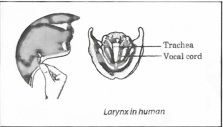
When the vocal cords are tight and thin, the type or quality of voice is different from that when they are loose and thick.
Question 13. Lightning and thunder take place in the sky at the same time and at the same distance from us. Lightening is seen earlier and thunder is heard later. Can you explain why?
Answer: Light travels at the speed of 3,00,000 km/s which is very large in comparison to the speed of sound which travels at the rate of 330 m/s in the air That is why lightning is seen earlier and thunder is heard later.
Kseeb Class 8 Science Sound Exercise Solutions
Sound Activities
Question 1. Take a metal plate (or a shallow pan). Hang it at a convenient place in such a way that it does not touch any wall. Now strike it with a stick Touch the plate or pan gently with your finger. Do you feel the vibrations? Again strike the plate with the stick and hold it tightly with your hands immediately after striking. Do you still hear the sound? Touch the plate after it stops producing sound. Can you feel vibrations now?

Answer: When we touch the pan gently with our finger after striking we feel the vibration. When we hold the pan tightly after striking it, we do not hear the sound. When the pan stops producing sound it also stops vibrating. Thus, we can conclude that the vibrating body produces sound.
Question 2. Take a rubber band. Put it around the longer side of a pencil box Insert two pencils between the box and the stretched rubber. Now, pluck the rubber band somewhere in the middle. Do you hear any sound? Does the band vibrate?
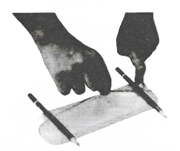
Answer: Yes, we hear the sound of plucking the rubber band. Also, we find that the band is vibrating. Thus, all vibrating bodies produce sound.
Question 3. Take a metal dish. Pour water into it. Strike it at its edge with a spoon Do you hear a sound? Again strike the dish and then touch it. Can you feel the dish vibrating? Strike the dish again. Look at the surface of the water. Do you see any waves there? Now hold the dish. What change do you observe on the surface of the water? Can you explain the change? Is there a hint to connect sound with the vibrations of a body?
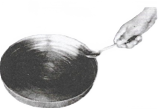
Answer: Onstriking the metal dish we hear sound and on touching it we feel the dish vibrating. Striking the dish with water we see circular waves produced. Thus vibrating object produces sound.
Karnataka Board 8th Science Chapter 9 Important Questions And Answers
Question 4. Take a hollow coconut shell and make a musical instrument ektara. You can also make it with the help of an earthen pot Play this instrument and identify its vibrating part.
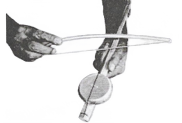
Answer: We observed that the vibrating part of the musical instrument ektara is stretched string.
Question 5. Take 6-8 bowls or tumblers. Fill them with water up to different levels, increasing gradually from one end to the other. Now take a pencil and strike the bowls gently. Strike all of them in succession. You will hear pleasant sounds.
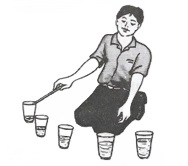
Answer: We can hear a pleasant sound. This is due to different levels of water in the bowls. Thus, we find that the shorter the length of the vibrating air column, the higher the pitch of the sound produced.
Question 6. Take two rubber strips of the same size. Place these two pieces one above the other and stretch them tight. Now blow air through the gap between them. As the air blows through the stretched rubber strips, a sound is produced. You can also take a piece of paper with a narrow slit and hold it between your fingers as shown in Now blow through the slit and listen to the sound.
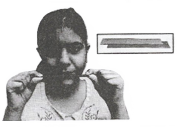
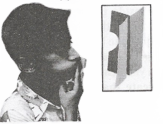
Answer: This activity shows that vocal cords also produce sound in a similar manner when they vibrate.
Kseeb Class 8 Science Chapter 9 Textbook Solutions
Question 7. Take a metal or glass tumbler. Make sure that it is dry. Place a cell phone in it. Ask your friend to give a ring on this cell phone from another cell phone. Listen to the ring carefully. Now, surround the rim of the tumbler with your handspun your mouth on the opening between your hands. Indicate to your friend to give me a ring again. Listen to the ring while sucking air from the tumbler. Does the sound become fainter as you suck air? Remove the tumbler from your mouth. Does the sound become loud again?
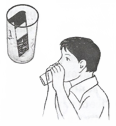 Answer: We observed that sound becomes fainter than earlier when we try to suck air. But when we remove the tumbler from our mouths the sound again becomes loud. Thus, sound needs a medium to travel.
Answer: We observed that sound becomes fainter than earlier when we try to suck air. But when we remove the tumbler from our mouths the sound again becomes loud. Thus, sound needs a medium to travel.
Question 8. Take a bucket or a bathtub. Fill it with clean water. Take a small bell in one hand. Shake this bell inside the water to produce sound. Make sure that the bell does not touch the body of the bucket or the tub. Place your ear gently on the water’s surface Can you hear the sound of the bell? Does it indicate that sound can travel through liquids?
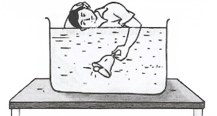 Answer: We can hear the sound of the bell which indicates that sound can travel through liquids.
Answer: We can hear the sound of the bell which indicates that sound can travel through liquids.
Kseeb 8th Standard Science Chapter 9 Notes And Solutions
Question 9. Take a meter scale or long metal rod and hold its one end to your ear. Ask your friend to gently scratch or tap at the other end of the scale Can you hear the sound of the scratching? Ask your friends around you if they were able to hear the same sound.
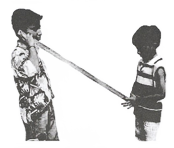 Answer: Yes, we find that we can hear the sound of the scratch. But, the people standing around us cannot hear the same sound or we can say that it is limping not audible to them.
Answer: Yes, we find that we can hear the sound of the scratch. But, the people standing around us cannot hear the same sound or we can say that it is limping not audible to them.
KSEEB Class 8 Sound Textbook Solutions
Question 10. Take a plastic or tin can. Cut its ends. Stretch a piece of rubber balloon across one end of the can and fasten it with a rubber band. Put four or five grains of dry cereal on the stretched rubber. Now ask your friend to speak” Hurrey, Hurrey” from the open end Observe what happens to the grain. Why does the grain jump up and down?
 Answer: The grain jumps up and down because of the vibration caused underneath the stretched rubber. Thus when sound waves fall on the eardrum, it starts vibrating back and forth rapidly.
Answer: The grain jumps up and down because of the vibration caused underneath the stretched rubber. Thus when sound waves fall on the eardrum, it starts vibrating back and forth rapidly.
Question 11. Take a metallic tumbler and a tablespoon. Strike the tablespoon gently at the brim of the tumbler. Hear the sound produced. Now bang the spoon on the tumbler and hear the sound produced again. Is the sound louder when the tumbler is struck hard? Now suspend a small thermal coal ball touching the rim of the tumbler Vibrate the tumbler by striking it. See how far the ball is displaced. The displacement of the ball is a measure of the amplitude of the vibration of the tumbler. Now, strike the tumbler gently and then with some force. Compare the amplitudes of vibrations of the tumbler in the two cases. In which case is the amplitude larger?
 Answer: The sound produced is louder when the tumbler is struck hard. The amplitude of vibration of the tumbler is larger when the glass is struck hard. Thus the loudness of sound depends upon the amplitude of vibration.
Answer: The sound produced is louder when the tumbler is struck hard. The amplitude of vibration of the tumbler is larger when the glass is struck hard. Thus the loudness of sound depends upon the amplitude of vibration.
Sound Additional Questions
Question 1. Define vibration.
Answer: Vibration is the to-and-fro or back-and-forth motion of an object.
Question 2. Which part of the human body is responsible for producing sound?
Answer: In humans, the sound is produced by the voice box or larynx
Question 3. Can Sound travel in a vacuum?
Answer: No, sound cannot travel in a vacuum.
Question 4. What is meant by oscillatory motion?
Answer: The to and fro motion of an object is known as oscillatory motion.
Question 5. Define 1 hertz.
Answer: A frequency of | hertz means one oscillation per second.
Question 6. What is a range of audible sounds?
Answer: Sound of frequency 20Hz to 20,000 Hz is the audible range.
Question 7. What is meant by noise pollution?
Answer: The presence of excessive or unwanted sound in the atmosphere is called noise pollution.
Question 8. How do plants help in reducing noise pollution?
Answer: Plants absorb sound and so help us in minimizing noise pollution.
Question 9. How can a hearing-impaired child communicate?
Answer: A hearing-impaired child can communicate effectively by using sign language.
Question 10. Which characteristic of a vibrating body determines
1. Loudness
2. What pitch of the sound is produced by it?
Answer: 1. Amplitude 2. Frequency.
Step-By-Step Solutions For Sound Class 8 Karnataka Board
Question 11. Why do we not hear echoes in our ordinary surroundings?
Answer: We do not hear echoes in our ordinary surroundings because the distance to hear echoes should be more than 17 m.
Question 12. We cannot hear the sound of the exploding meteors in the sky, though we can see them. Why?
Answer: Sound cannot travel through a vacuum. In space, there is a vacuum. Light can travel through a vacuum, so we can see the exploding meteor but cannot hear the explosion.
Question 13. When does a thud become music?
Answer: When thuds are repeated at regular intervals, it becomes music, For Example, the beating of drums or wood.
Question 14. Give an example of each of the:
1. Stringed instrument
2. Percussion instrument
3. Wind instrument
4. Striking instrument
Answer:
1. Violin
2. Drums
3. Flute
4. Jal Tarang
Question 15. What is the difference between noise and music? Can music become noise sometimes,?
Answer: Unpleasant sounds are called noise. Music is a sound that produces a pleasing sensation. If the music is too loud, it becomes noise.
Question 16. Draw a labeled diagram showing the structure of the human ear?
Answer:
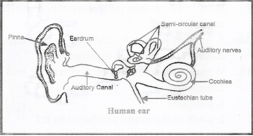
Question 17. What are ultrasounds? How are they useful to us?
Answer: Sound having a frequency higher than 20kHz is known as ultrasound, and is used for
- Detecting finer faults in metal sheets.
- Scanning and imaging the body for stones, tumors, and fetuses.
Sound Class 8 KSEEB Exercise Solutions
Sound Multiple Choice Questions
Question 18. A list of mediums is given below.
1. Wood
2. Water
3. Air
4. Vacuum
In which of these mediums can sound travel?
Answer:
1. Wood
2. Water
3. Air
Explanation: Sound required a medium to travel. In a vacuum there is no medium to transmit sound waves hence sound cannot travel in a vacuum.
Question 19. The loudness of a sound depends on:
1. Its amplitude
2. Its frequency
3. Its time period
4. Its speed.
Answer: 1. Its amplitude.
Explanation: Loudness is directly proportional to the amplitude of sound waves. If the amplitude is high then the sound will be louder and the sound will be feeble if the amplitude is low.
Question 20. Which of the following statements is correct?
1. Sound is produced by vibrations.
2. Sound requires a medium for propagation.
3. Light and sound both require a medium for propagation.
4. Sound travels slower than light.
Answer:
1. Sound is produced by vibrations.
2. Sound requires a medium for propagation.
4. Sound travels slower than light.
Explanation: Statement 3. is wrong because light and sound are two different entities.
Question 21. An object is vibrating at 50 hertz. What is its time period?
1. 0.02 s
2. 2s
3. 0.2 s
4. 20.0 s
Answer: 1. 0.02 s
Explanation: If an object is vibrating at 50 hertz
50=1/1T
T=1/50
T=0:02s
Its time period will be 0.02 sec
Question 22. In order to reduce the loudness of a sound, we have to
1. Decrease the frequency of vibration of the sound.
2. Increase the frequency of vibration of the sound.
3. Decrease the amplitude of the vibration of the sound.
4. Increase the amplitude of the vibration of the sound.
Answer: 3. Decrease the amplitude of the vibration of the sound.
Explanation: Sound is directly proportional to the loudness of sound. Hence by decreasing amplitude loudness of the sound decreases.
Question 23. The loudness of sound is measured in units of
1. Decibel (dB)
2. Hertz (Hz)
3. Metre (m)
4. Metre/Second (m/s)
Answer: 1. Decibel (dB)
Question 24. The loudness of sound is determined by the
1. Amplitude of vibration
2. The ratio of amplitude and frequency of vibration
3. Frequency of vibration
4. Product of amplitude and frequency of vibration
Answer: 1. Amplitude of vibration
Explanation: Loudness is directly proportional to the amplitude of sound waves. If the amplitude is high then the sound will be louder and the sound will be feeble if the amplitude is low.
Question 25. Lhertzis equal to
1. 1 vibration per minute
2. 10 vibrations per minute
3. 60 vibrations per minute
4. 600 vibrations per minute
Answer: 3. 60 vibrations per minute
Explanation: 1Hz= | vibration/second
1 minute=60 seconds hence 1 hertz = 60 vibrations /minute
Question 26. The Pitch of sound is determined by its
1. Frequency
2. Amplitude
3. Speed
4. Loudness
Answer: 1. Frequency
Question 27. Ultrasound has a frequency of vibration
1. Between 20 and 20,000 Hz
2. Below 20 Hz
3. Above 20,000 Hz
4. Between 500 and 10,000 Hz
Answer: 3. Above 20,000 Hz
Question 28. Lightning can be seen the moment it occurs. Paheli observes lightning in her area. She hears the sound 5s after she observed lightning. How far is she from the place where lightning occurs? (speed of sound = 330 m/s).
Answer: Distance=330ms x 5s= 1650m
Question 29. Does any part of our body vibrate when we speak? Name the part.
Answer: The larynx or vocal cords vibrate when we speak.
Question 30. Boojho saw a cracker burst at night at a distance from his house. He heard the sound of the cracker a little later after seeing the cracker burst. Give the reason for the delay in hearing the sound.
Answer: The speed of light is faster than the speed of sound, hence Boojho heard the sound of the cracker a little later after seeing the cracker burst.
Question 31. When we hear a sound, does any part of our body vibrate? Name the part.
Answer: When we hear a sound our eardrum vibrates.
Question 32. Name two musical instruments which produce sound by vibrating strings.
Answer: Sitar and Veena
Question 33. A simple pendulum makes 10 oscillations in 20 seconds. What is the time period and frequency of its oscillation?
Answer:
Time period: 2 s
Frequency: 0.5 oscillations/sec
Explanation: A pendulum makes 10 oscillations in 20 seconds.
So it makes 1 oscillation in 20/10 = 2sec
Time period=2 sec
Frequency= 1/t = 1/2 = 0.5Hz
Question 34. We have learned that vibration is necessary for producing sound. Explain why the sound produced by every vibrating body cannot be heard by us.
Answer: Everybody has their own range of frequency. But we can only hear frequencies in the range of 20hz to 2000 Hz so we cannot hear the sound of a few vibrating bodies.
Question 35. Suppose a stick is struck against a frying pan in a vacuum. Will the frying pan vibrate? Will we be able to hear the sound? Explain.
Answer: The frying pan will vibrate. We will not be able to hear the sound of vibration because sound cannot travel in a vacuum.
Question 36. Two astronauts are floating close to each other in space. Can they talk to each other without using any special device? Give reasons.
Answer: In space, there will be no medium for sound waves to travel and it will be the vacuum. Sound cannot travel in a vacuum hence sound cannot be heard without any special device.
Question 37. List three sources of noise pollution in your locality.
Answer: Industrial sirens, Vehicle honking, and bursting crackers.
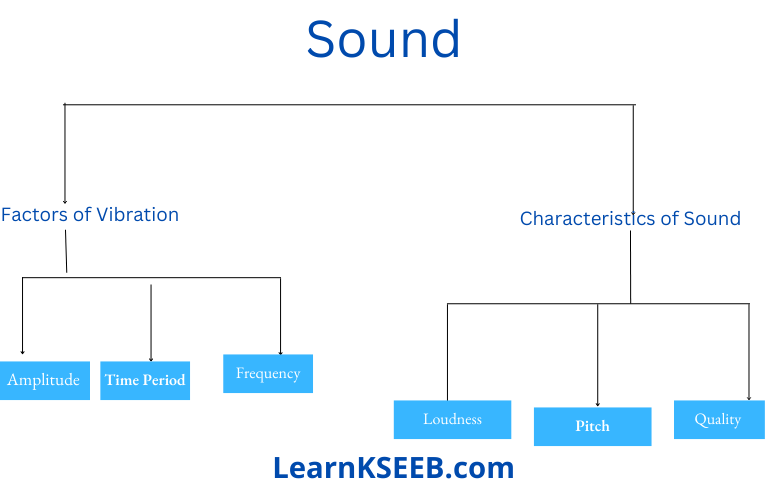
Karnataka State Board Syllabus for Class 8 Textbooks Solutions
- Chapter 1 Crop Production and Management
- Chapter 2 Microorganisms: Friend and Foe
- Chapter 3 Synthetic Fibres and Plastics
- Chapter 4 Materials: metals and Non-Metals
- Chapter 5 Coal and Petroleum
- Chapter 6 Conservation of Plants and Animals
- Chapter 7 Force and Pressure
- Chapter 8 Friction
- Chapter 9 Sound
- Chapter 10 Combustion and Flame
- Chapter 11 Cell Structure and Functions
- Chapter 12 Reproduction in Animals
- Chapter 13 Reaching the age of Adolescence
- Chapter 14 Chemical Effects of Electric Current
- Chapter 15 Some Natural Phenomena
- Chapter 16 Light
- Chapter 17 Stars and the Solar System
- Chapter 18 Pollution of Air and Water
